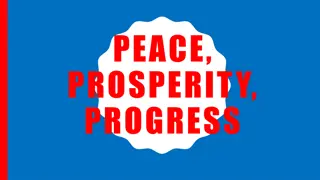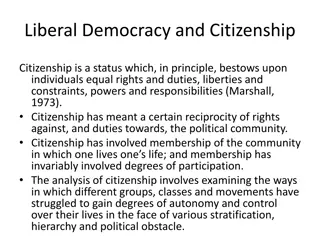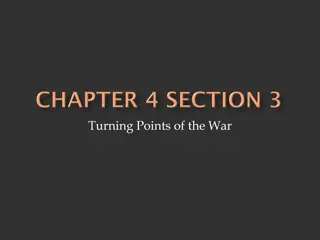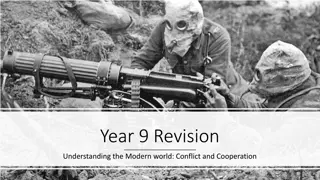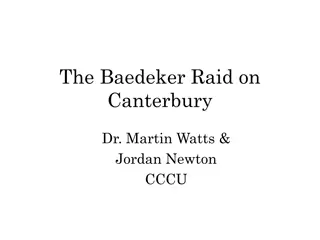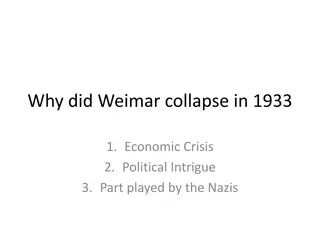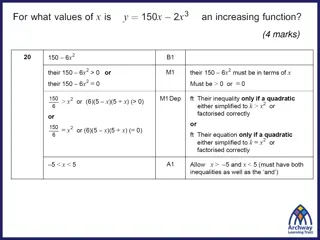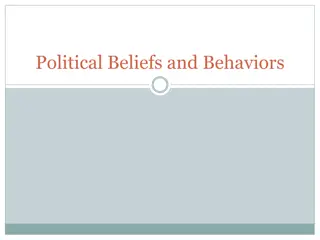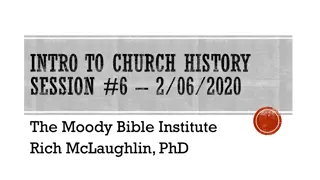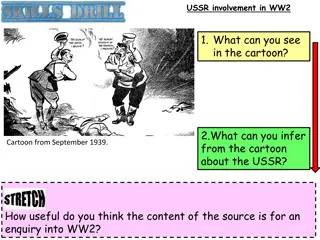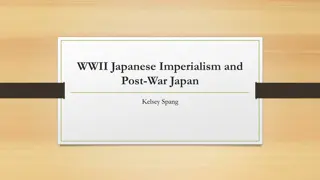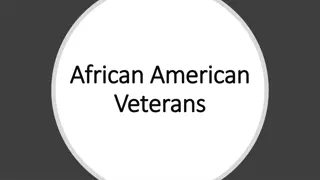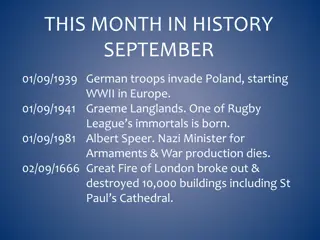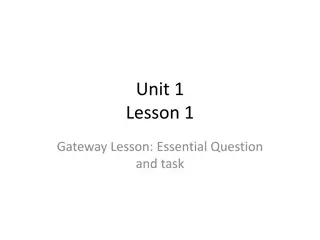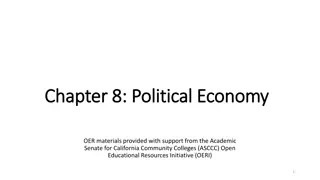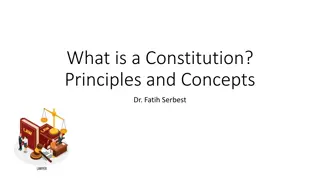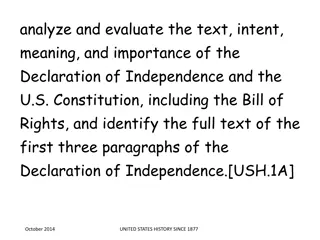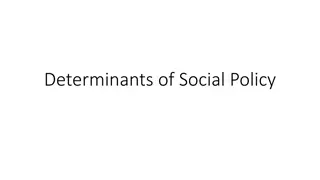Impact of WWII on US Homefront: Social, Political, and Economic Turning Points
Investigate the significant shifts in the US homefront during WWII through social, political, and economic lenses. Explore the changes in the economy, roles of African Americans and women, and the transformation of civilian life. Reflect on major events like the involvement of the Tuskegee Airmen, increased women participation, and the effects of war bonds on financing military operations.
Download Presentation

Please find below an Image/Link to download the presentation.
The content on the website is provided AS IS for your information and personal use only. It may not be sold, licensed, or shared on other websites without obtaining consent from the author. Download presentation by click this link. If you encounter any issues during the download, it is possible that the publisher has removed the file from their server.
E N D
Presentation Transcript
Beginning Assessment: Using your prior knowledge, label the statement as either a Social, Political, or Economic turning point for the US. Tuskegee Airmen were the first African American soldiers to successfully complete their training and enter the Army Air Corps. During WWII, the unemployment rate dropped. On September 16, 1940, the United States instituted the Selective Training and Service Act of 1940, which required all men between the ages of 21 and 45 to register for the draft. The United States dropped 2 atomic bombs on the Japanese cities of Hiroshima and Nagasaki. The role for women changed during WWII. On June 6, 1944 (D-Day) the Allied forces attacked German forces on the coast of Normandy, France. The Allies gained a victory that became the turning point for World War II in Europe. American factories were retooled to produce goods to support the war effort. The war set families in motion, pulling them off of farms and out of small towns which sparked urban growth. Roosevelt issued an executive order prohibiting discrimination in defense industries and creating the Fair Employment Practices Commission (FEPC). War Bonds were sold to help finance military operations.
Unpack/Annotate LTs Learning Target: I can investigate how US participation in WWII created major changes on the homefront for the economy, African Americans, women, and everyday life for civilians.
Gallery Walk Posters--Turning points on the US homefront during WWII First ---read and analyze all text--provide description on note catcher Second---analyze all photos and capture their observations on note catcher Third-----THINK! provide a written description of the turning point that the text and photos represent
Poster 1 Theme: Social Change, Women in U.S. Military 1. Detailed Notes from test The first contingent of U.S. Army nurses to be sent to an Allied advanced base in New Guinea carry their equipment as they march single file to their quarter on November 12, 1942. Some 300,000 women served in the army, navy and nursing corps, and a quarter of these served overseas. U.S. nurses walk along a beach in Normandy, France on July 4, 1944, after they had waded through the surf from their landing craft. They are on their way to field hospitals to care for the wounded allied soldiers
Poster 1 Theme: Social Change, Women in U.S. Military 2. What do you observe happening in these photos?
Poster 1 Theme: Social Change, Women in U.S. Military 3. THINK! 3. Fully describe the turning point this poster represents.
Poster 2 Theme: Social Change, African Americans in WWII 1. Detailed Notes from test A Naval Hero (2 slides) On December 7, 1941, during the Japanese attack on Pearl Harbor, Mess Attendant Doris "Dorie" Miller came to the aid of his shipmates on the U.S.S. West Virginia, helping to move the injured out of harm's way, including the mortally wounded captain. Though untrained in its use, Miller also manned an anti aircraft machine gun, downing several Japanese planes before being ordered to abandon the sinking ship. Miller's courage and devotion to duty at Pearl Harbor earned him the Navy Cross, the first ever awarded to an African American sailor. This honor is even greater in light of the fact African Americans were only allowed to serve in the messman's branch of the Navy at the time. Though later killed in action in 1943, Miller's legacy of bravery in the face of great danger and discrimination lives on. A Threatened march on Washington- 1941 The papers of A. Philip Randolph document his protests against segregation, particularly in the armed forces and defense industries during the war. Randolph led a successful movement during World War II to end segregation in defense industries by threatening to bring thousands of blacks to protest in Washington, D. C., in 1941. The threatened March on Washington in 1941 prompted President Franklin D. Roosevelt to issue Executive Order 8802, stating that there should be "no discrimination in the employment of workers in defense industries or Government because of race, creed, color, or national origin." The Committee on Fair Employment Practices was established to handle discrimination complaints.
Members of the Women's Army Corps (WAC) pose at Camp Shanks, New York, before leaving from New York Port of Embarkation on February 2, 1945. The women are with the first contingent of Black American WACs to go overseas for the war effort. March 1948, First Lieutenant Nancy C. Leftenant entered the Regular Army Nurse Corps, becoming the corps first black members. African American Nurses Abroad Even though an extreme shortage of nurses in World War II forced the federal government to seriously consider drafting white nurses, defense officials remained reluctant to recruit black nurses throughout the war. Allowing black nurses to care for whites was considered a violation of social norms. Nevertheless, the National Association of Colored Graduate Nurses, led by Mabel Staupers, and rights groups like the NAACP, loudly protested racial policies in the Army Nurse Corps and the military in general.
Poster 2 Theme: Social Change, African Americans in WWII 2. What do you observe happening in these photos?
Poster 2 Theme: Social Change, African Americans in WWII 3. THINK! 3. Fully describe the turning point this poster represents.
Poster 3 Theme: Economic Change, Wartime Production, Women in Industry 1. Detailed Notes from test Before the war few women followed careers. Most jobs for women were traditional roles such as nursing, secretarial or caring jobs. The war production effort brought immense changes to American life. As millions of men and women entered the service and production boomed, unemployment virtually disappeared. The need for labor opened up new opportunities for women and African Americans and other minorities. Millions of Americans left home to take jobs in war plants that sprang up around the nation. Economic output skyrocketed. Women in industry- Millions of men joined the armed forces, more workers were needed to fill their places in the factories. This changed the traditional views of women. Job opportunities in munitions factories for working-class women allowed them to earn a much higher wage than before. "I need not repeat the figures. The facts speak for themselves.... These men could not have been armed and equipped as they are had it not been for the miracle of production here at home. The production which has flowed from the country to all the battlefronts of the world has been due to the efforts of American business, American labor, and American farmers, working together as a patriotic team." --President Franklin D. Roosevelt, Navy Day speech, October 27, 1944 Women became machinists, lumberjacks, dockers and railway engineers. In 1939 only 36 women were employed in shipbuilding. By 1943 the number was 200,000.
Poster 3 Theme: Economic Change, Wartime Production, Women in Industry 2. What do you observe happening in these photos?
Poster 3 Theme: Economic Change, Wartime Production, Women in Industry 3. THINK! 3. Fully describe the turning point this poster represents.
Poster 4--Theme: Social Change, Civil Liberties, Censorship 1. Detailed Notes from test CIVIL LIBERTIES, WORLD WAR II The federal government, in response to periods of insecurity and conflict, sometimes restricts civil liberties in an effort to maintain national security. In the wake of the attack on Pearl Harbor, the federal government took into custody almost 11,000 persons it considered enemy aliens. The arrest of the 8,000 Japanese Americans, 2,300 German Americans, and several hundred Italian Americans followed due process of law. However, on February 19, 1942, Executive Order 9066 provided the initial authority for the roundup and internment of approximately 120,000 Japanese Americans, including those who were American citizens. Congress later passed legislation to enforce the order. The Japanese Americans affected by the mandate, primarily those living on the West Coast, were divided and sent to ten detention centers located in California, Arizona, Idaho, Wyoming, Colorado, and Arkansas. (2 slides) The Office of Censorship, an emergency wartime agency, heavily censored reporting during World War II. During World War II, war correspondents accompanied military forces, and their reports were subject to advance censorship to preserve military secrets. On December 19, 1941 President Franklin Roosevelt signed Executive Order 8985, which established the Office of Censorship. Censorship was not limited to reporting; postal censorship also took place. "Every letter that crossed international or U.S. territorial borders from December 1941 to August 1945 was subject to being opened and scoured for details."
Rochester During the war, Cobbs Hill Park was used as a Prisoner of War camp. The first POWs arrived September 28, 1943. Sixty Italian prisoners worked on area farms and food processing plants 10 hours a day, six days a week, at $0.80 per day. After Italy capitulated to the Allies October 12, 1943, and joined the war against Germany the Italian POW's became unguarded internees. The Italians were replaced at Cobbs Hill with German POWS June 26, 1944. The city was hit in February 1945 with seven successive snowstorms that paralyzed the city, forcing the city to ask that POWs be brought from the Hamlin Camp to the city. Cobbs Hill Park housed 100 Germans, while 175 more were at Edgerton Park. Snow removal by prisoners was done at unannounced locations, with city police guarding the POWs.
Poster 4--Theme: Social Change, Civil Liberties, Censorship 2. What do you observe happening in these photos?
Poster 4 Theme: Social Change, Civil Liberties, Censorship 3. THINK! 3. Fully describe the turning point this poster represents.
Poster 5 Theme: Economic Change, Rationing, Victory Gardens, ALL Civilians during WWII 1. Detailed Notes from test Everyone was called on to "Do Your Part." They were encouraged to defend the country and support the war effort. "Don't you know there's a war on? "Food for Victory" To conserve and produce more food, a "Food for Victory" campaign was launched. Eating leftovers became a patriotic duty and civilians were urged to grow their own vegetables and fruits. Millions of "Victory gardens," planted and maintained by ordinary citizens, appeared in backyards, vacant lots, and public parks. They produced over 1 billion tons of food. Americans canned food at home and consulted "Victory cookbooks" for recipes and tips to make the most of rationed goods. The war effort on the "Home Front" required sacrifices and cooperation. "Don't you know there's a war on?" was a common expression. Rationing became part of everyday life. Americans learned to conserve vital resources. They lived with price controls, dealt with shortages of everything from nylons to housing, and volunteered for jobs ranging from air raid warden to Red Cross worker. In April, 1942, FDR addressed the nation and called everyone to action. "One front and one battle where everyone in the United States every man, woman and child is in action. That front is right here at home, in our daily lives."
Poster 5-Theme: Economic Change, Rationing, Victory Gardens, ALL Civilians during WWII 2. What do you observe happening in these photos?
Poster 5 Theme: Economic Change, Rationing, Victory Gardens, ALL Civilians during WWII 3. THINK! 3. Fully describe the turning point this poster represents.
Create web diagram or graphic organizer representing all aspects of how US participation in WWII created major changes on the homefront for the economy, African Americans, women, and everyday life for civilians Closing Assessment Display a minimum of 4 social and/or economic turning points that took place on the US homefront during WWII. You must include a description about the significance of the turning point . Be creative!




